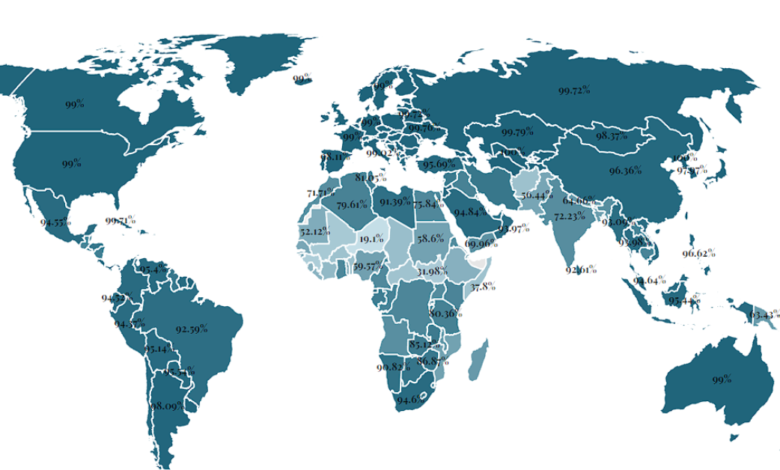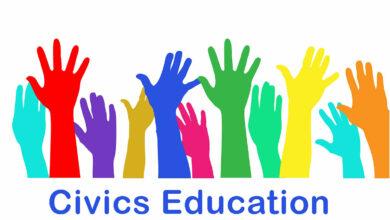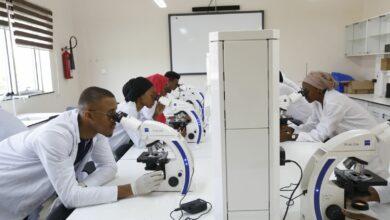
Top 10 Countries with high illiteracy rates in the World
Illiteracy remains a major global issue in 2023, with millions of adults lacking basic reading and writing skills. While developed nations have made strides in promoting literacy, many developing countries still contend with high illiteracy rates, according to World Population Review. This impacts economic growth, healthcare outcomes, and more.InformationGuideNigeria
In this article, we will examine the top 10 countries with the highest illiteracy rates worldwide. The data is compiled from sources from World Population Review. Countries are ranked based on the percentage of their adult population aged 15 and over who are illiterate. Let’s review the worst literacy crisis spots globally and the unique challenges they face.
👉 Relocate to Canada Today!
Live, Study and Work in Canada. No Payment is Required! Hurry Now click here to Apply >> Immigrate to CanadaTop 10 Countries with high illiteracy rates in the World:
1. Chad – 22.31%
Chad has the dubious distinction of having the highest illiteracy rate globally. Landlocked in Central Africa, Chad has a population of 17.18 million people based on 2022 estimates. Out of this, 22.31% of adults aged 15 and above are illiterate according to a 2016 study. The literacy rate stands at just 77.69%.
Illiteracy is higher among women at 29.33% compared to men at 15.15%. Geographically, illiteracy rates vary from 6.32% in the capital N’Djamena to over 40% in the Lac region. Poverty, lack of schools, and cultural attitudes are factors behind Chad’s high illiteracy. Chad also has the 5th highest rate of out-of-school children in the world.
Read Also: 10 Ways To Stop Nigerians From Flocking To Other Countries
Low literacy impacts Chad’s economy, healthcare, governance, and more. Agriculture dominates, employing over 70% of Chadians. Illiteracy makes it harder to improve farming methods. Healthcare suffers too as illiterate adults struggle to access and understand treatment. Gender inequality persists as well, with literate women better able to exercise autonomy and rights.Top 10 Countries with high illiteracy rates in the World
To combat illiteracy, Chad needs more schools, qualified teachers, and educational initiatives tailored to women and rural communities. Government campaigns like “Operation 500,000 Literate” are a start but remain underfunded and limited in scope. Foreign aid focused on education could significantly move the needle on Chad’s literacy crisis.
2. Guinea – 32.00%
Guinea is another African nation with low literacy, coming in 2nd with an illiteracy rate of 32.0% as of 2014. Located on the Atlantic coast, the population of Guinea is around 13.41 million.
Women fare worse than men, with 47.36% illiterate compared to 18.10% of men. Rural areas have higher illiteracy than cities like the capital Conakry.
Poverty, lack of access to education, and cultural/religious attitudes contribute to illiteracy. Many families rely on children to work rather than attend school. Gender roles hinder girls’ education especially. Islamic schools teach religion but not literacy skills.
👉 Relocate to Canada Today!
Live, Study and Work in Canada. No Payment is Required! Hurry Now click here to Apply >> Immigrate to CanadaGuinea’s high illiteracy inhibits economic prosperity and civic participation. Low-skilled workers have fewer job options. Illiterate adults cannot engage fully with banks, courts, voting, and more. Maternal and infant health also suffer as mothers cannot access written health information.
Guinea requires major educational expansion to boost literacy. More schools, teachers, teaching materials, and programs for women/girls are urgently needed. Adult literacy classes are also a worthwhile investment to reach older generations. Given Guinea’s youthful population, acting now to increase literacy can pay huge dividends.
Read Also: List of the Top 10 Internet Scamming Countries in the World
3. South Sudan – 34.52%
The world’s newest nation, South Sudan split from Sudan in 2011 after decades of conflict. Since then, the young country has faced ongoing instability and violence. Amid these challenges, South Sudan contends with an illiteracy rate of 34.52% as per 2018 data. This equals around 4 million illiterate adults out of the total population of 10.7 million.
As in Chad and Guinea, women fare worse at 56.16% illiteracy compared to men at 25.23%. Poverty, lack of schools, and cultural gender roles contribute to the problem. South Sudan has one of the world’s lowest primary school completion rates at 34%. The conflict has damaged and shuttered many schools as well.
Illiteracy hampers South Sudan across the board. Illegal child labor persists, economic productivity lags and public health suffers. Civic unrest and lack of governance are worsened too due to citizens being unable to effectively participate.Top 15 Best Guitarists of all Time
To improve literacy, South Sudan needs peace and investment in education. More primary schools, teachers, and learning materials are critical first steps. Programs to expand girls’ access to schooling are also vital. Until stability and educational access grow, South Sudan will remain locked in crisis with high illiteracy inhibiting progress.
4. Niger – 35.05%
Niger is a landlocked Sub-Saharan nation struggling with major illiteracy. As of 2018, over one-third of adults aged 15 and over were illiterate at 35.05%. For a country with a population of 25.25 million, this translates to around 8.5 million non-literate adults.
Women again fare worse than men, with 48.71% illiteracy for women against 22.98% for men. Geographically, urban populations in cities have higher literacy than rural areas where school access suffers. High dropout rates play a role, along with cultural attitudes deprioritizing education.
Niger is one of the poorest nations worldwide, with over 40% living on under $1.90 daily. Widespread illiteracy entrenches this poverty further. Illiterate farmers cannot enhance agricultural practices. Healthcare education is hindered too. On the positive side, younger generations have increased access to schooling, signaling hope for Niger’s future.
Increasing literacy requires expanded educational access and opportunities for women/girls. Secondary schools and vocational programs are also needed for those finishing primary education. Given the linguistic diversity in Niger, teaching materials in local languages could also boost learning. With sustained effort, Niger may reduce illiteracy in the coming decades.
Read Also: Top 15 Countries with high infant mortality rates in Africa
5. Mali – 35.47%
Like its neighbor Niger, the West African nation of Mali also has alarming illiteracy rates. As of 2018, over one-third of Malian adults are illiterate at 35.47%. The exact figure equals around 4.5 million non-literate adults out of 16.3 million total.
Looking closer, 46.34% of Malian women are illiterate versus 25.17% of men. Geographically, northern regions show higher illiteracy linked to poverty, lack of schools, and cultural factors. Southern urban centers like the capital Bamako have higher literacy. Mali’s youth literacy rate has progressed, but adult illiteracy remains entrenched.14 Best Female Coaches of all Time
Consequences include weaker farming, healthcare, governance, and gender equality. Illiteracy costs Mali-an estimated 2.2% in lost GDP annually. It also fuels unemployment, especially for women. But increased enrollment plus more schools and teaching resources can continue improving Mali’s situation. Better technical and vocational training is also essential to equip youth for skilled work.
6. Central African Republic – 37.40%
As its name denotes, the landlocked Central African Republic sits at the heart of the African continent. This volatile nation has suffered years of conflict and political instability. Amidst this insecurity, 37.4% of Central African Republic adults are illiterate as of 2022. For a population of around 5.3 million, this totals nearly 2 million non-literate adults.
Illiteracy hits women harder at 41.84% compared to men at 33.45%. Rural areas also lag behind cities in literacy and school access. The ongoing violence has damaged many educational facilities as well. Poverty and lack of state services contribute greatly to illiteracy across the Central African Republic.
With low literacy, the Central African Republic misses opportunities in farming, business, governance, and more. Healthcare is impacted as health information cannot be conveyed properly. Peace and security are essential before literacy rates can substantially improve through restored education access. More parental awareness of schooling’s importance is also key.
Read Also: Top 10 Highest Oil Producing Countries in Africa
7. Burkina Faso – 41.22%
Burkina Faso is another of Africa’s least literate nations, with a 2018 illiteracy rate of 41.22%. Out of its 22.1 million people, around 8.9 million adults lack basic literacy and writing abilities.
Here too we see a sizable gender gap, with 52.18% of women being illiterate versus 31.59% of men. Rates are lower in cities and higher in rural communities facing shortages of schools and teachers. Lack of electricity and school supplies also hinder literacy progress.
The consequences of illiteracy for Burkina Faso include reduced economic productivity, fewer job opportunities, impaired civic participation, and more. Increased investment in education is needed, especially for rural areas and girls and women. Adult literacy programs can also help reach older non-literate Burkinabes to boost literacy over time.105 Good Morning My Love Messages
8. Benin – 42.36%
Benin is a coastal West African country surrounded by neighbors with high illiteracy. As of 2018, 42.36% of Benin’s adults are illiterate equaling around 3.8 million people. This is despite above-average youth literacy, showing the lingering effects of past educational gaps.
Breaking down the data, women have a 56.73% illiteracy rate compared to 29.32% for men. Poverty and cultural gender roles contribute to the disparity. Geographically, northern rural regions of Benin have higher illiteracy than southern areas and main cities.
Consequences of illiteracy include slower economic growth. Illiteracy also limits healthcare outreach and access to government services. On a positive note, Benin has made strides in boosting youth literacy via school expansion and educational reforms. Continued efforts focused on women and rural populations can further cut illiteracy.
Read Also: Top 15 Least Developed Countries in the World
9. Afghanistan – 43.02%
Afghanistan has suffered from decades of conflict and instability, causing widespread illiteracy. As of 2018, Afghanistan has an illiteracy rate of 43.02% equaling 10.7 million non-literate adults. The rural-urban divide is also stark, with 57% rural illiteracy but just 25% in city centers like Kabul.
In terms of gender, 55.77% of Afghan women are illiterate versus 31.75% of men. Poverty plus cultural and religious norms have limited female education. Safety concerns further keep girls out of school, especially under Taliban control since 2021. Lack of qualified teachers and school materials are other factors.
High illiteracy impacts all facets of Afghan society. Healthcare, economic productivity, governance, and human rights are all affected. Restoring educational access, especially for girls, is crucial. Community awareness campaigns promoting literacy can also make progress over time if undertaken effectively. But without greater stability, literacy will remain a profound challenge.200 Romantic Message for Her
#10. Sierra Leone – 43.21%
Rounding out the list is the West African nation of Sierra Leone with 43.21% illiteracy in 2018. Of around 8 million citizens, over 3.5 million lack basic literacy abilities.NYSC Portal
Similar to other nations listed, illiteracy in Sierra Leone has a considerable gender imbalance – 60.84% for women versus 26.81% for men. Geographically, rural areas have higher illiteracy than urban centers. The 14-year civil war ending in 2002 destroyed many schools and displaced teachers. Infrastructure and school access have improved since, but illiteracy remains high.
Consequences include reduced economic productivity, civic participation, and more. Health outcomes suffer as illiterate adults cannot access healthcare information. On a positive note, youth literacy rates have risen, signaling a brighter future. Continuing to improve access to education and literacy training, especially for girls and rural communities, will help Sierra Leone reduce illiteracy rates in the long term.JAMB Portal
Read Also: Top 15 Countries with high unemployment rates in Africa
Conclusion
Sub-Saharan Africa faces the greatest global illiteracy burden. Myriad factors like poverty, limited school access, gender gaps, conflict, and cultural biases drive high regional rates. Tackling illiteracy requires expanding educational access at all levels, especially for women, girls, and rural populations. Adult literacy programs can also help. With adequate political commitment and resources, literacy rates in these nations can significantly rise long term. Increased literacy will empower individuals and societies, driving improvements in economic prosperity, health, governance, and human rights. Making universal literacy attainable should be a top global priority.
Check: JAMB Result
Check and Confirm: How Much is Dollar to Naira








